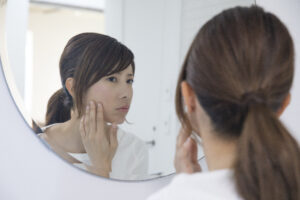 Summer is here and so is the need for sunscreens and skin protection! To safely enjoy your time at the pool, shore, or park, remember there are two types of UV light that can harm your skin: UVA and UVB. Too much exposure can cause skin cancer. UVA light prematurely ages your skin, causing wrinkles and spots, while UVB light leads to sunburns. Though you should avoid the sun during the peak hours of 10 a.m. to 4 p.m., you should also choose a broad-spectrum sunscreen that protects you from UV light.
Summer is here and so is the need for sunscreens and skin protection! To safely enjoy your time at the pool, shore, or park, remember there are two types of UV light that can harm your skin: UVA and UVB. Too much exposure can cause skin cancer. UVA light prematurely ages your skin, causing wrinkles and spots, while UVB light leads to sunburns. Though you should avoid the sun during the peak hours of 10 a.m. to 4 p.m., you should also choose a broad-spectrum sunscreen that protects you from UV light.
What about SPF?
Often, we may think that the higher the SPF, the closer to sun safety. However, high-number SPFs offer the same protection as low-number SPFs. You should use a sunscreen of at least 30 SPF, and keep in mind SPFs greater than 50 provide only a small increase in UV protection.
Effectiveness
Though it would be ideal, putting on moisturizer with sunblock in the morning does not last the whole day. It can be washed off when swimming, or even sweating, and we tend to not apply a thick enough layer in the first place. Water-resistant sunscreens are not a solution either: they last about 40 minutes in water. High water-resistant products last up to 80 minutes.
Types of Skin
The biggest question is whether we should use sun lotion/cream or a spray. Here are some basic differences you may want to consider:
- Lotions and creams: if you have dry skin, go for a cream sunscreen, especially on the face. Around your eyes, you can use a stick and for large areas, use a lotion.
- Gel and sprays: gels are very useful in hairy areas, and sprays offer an easy way to put sunscreen on your children. Be generous when spraying so that you end up with a thick coating, but don’t spray around the eyes and nose.
Aging
If you want the use of sunscreen to be effective in preventing aging, wrinkles, and sunspots, get in the habit of using it every day. This means, it’s not only for special occasions or only during the summer. Those who use broad-spectrum sunscreen daily show 24% less signs of aging than those who use it intermittently. In addition to the sunscreen, wear protective clothing that covers the arms and chest. Use hats and sunglasses to protect your head and eyes and find shade whenever possible.
Acne
One of the most common resistances to sunscreen is that it causes oily or acne-prone skin to break out even more, as it clogs the pores and is, simply, very thick. However, do not let that keep you from protecting your skin from UV rays: there are lightweight, oil-free, and non-comedogenic sunscreens available. Some of them even include lactic acid, perlite, silica control shine and antioxidants to work with oily skin and prevent breakouts while protecting you.
More
By Iris Farrou
09 Feb, 2021
Menstruation
Best gyns in Buffalo, Best OB practices in Buffalo, Best OBGYN Groups in Buffalo, Buffalo OB-GYN, Buffalo OBGYN, Chouchani MD, skincare, WNY OB-GYN, WNY Ob-gyn doctors, WNY OBGYN, women's health
 It’s not a secret that menstrual cycles causes all sorts of changes to our bodies, our moods, our hair, etc, but our cycle also brings about changes to our skin. You may be surprised to find out it’s not only during menstruation and the frequent breakout that accompanies it that our hormones are at work. In fact, estrogen, progesterone, and testosterone work hard throughout our menstrual cycle to ensure that they are causing changes to our skin. You can check the best laser hair removal in Las Vegas, NV and know where to go to get a glow up.
It’s not a secret that menstrual cycles causes all sorts of changes to our bodies, our moods, our hair, etc, but our cycle also brings about changes to our skin. You may be surprised to find out it’s not only during menstruation and the frequent breakout that accompanies it that our hormones are at work. In fact, estrogen, progesterone, and testosterone work hard throughout our menstrual cycle to ensure that they are causing changes to our skin. You can check the best laser hair removal in Las Vegas, NV and know where to go to get a glow up.
Shark Week
During our periods, and especially on the first day, all our hormones are at their lowest levels. You may have noticed not only the breakouts but also the lack of moisture—this is due to the low sebum production. It is ideal to consume more water to help your skin retain hydration, and to use a moisturizer or serum high in hyaluronic acid. Increased pain sensitivity is also noticed during that time, so try to avoid procedures that would be painful (like waxing). For the Top 7 Benefits of CoolSculpting, and the way it benefits the skin, it is best to check out this link!
Venus Week
After menstruation ends, our skin begins the process of producing estrogen anew. You have probably noticed that in the days after your period your skin glows more and may feel more youthful or plump. The increased levels of estrogen mean that collagen, elastin, and hyaluronic acid are created, leading to stronger elastic cells. If you want to help your skin with this turnover process, you can consider exfoliating. It is generally suggested that you use gentle and natural exfoliants and lessen the amount of makeup so that you give your skin a chance to breathe. Lowering your sugar and carb intake during this week will also help your skin glow even more!
Minerva Phase
After ovulation, female bodies pump up the levels of progesterone—the hormone responsible for “watching after” potential pregnancies. This surge leads to more sebum production, swelling of your skin and compression of pores. This is the phase when more oil is likely to be trapped in our skin pores, thus causing the dreaded breakout to commence. You may also feel more bloated during this time, as our metabolism tends to slow down. As far as your skincare routine goes in this phase, you want to ensure that you are using products that help with the excess oil: cleanse with a gentle toner, add a clay mask to your routine, or use spot-on acne treatment for potential blemishes.
Takeaway
Being cognizant of the hormonal changes during your menstrual cycle can certainly help you take better care of your skin, and possibly lessen the personal guilt that comes with blemishes or dry skin! However, there may always be other conditions that cause skin problems so always check with your doctor before drastically changing your skincare routine, or if you are on any medications that might affect it.
More
 Summer is here and so is the need for sunscreens and skin protection! To safely enjoy your time at the pool, shore, or park, remember there are two types of UV light that can harm your skin: UVA and UVB. Too much exposure can cause skin cancer. UVA light prematurely ages your skin, causing wrinkles and spots, while UVB light leads to sunburns. Though you should avoid the sun during the peak hours of 10 a.m. to 4 p.m., you should also choose a broad-spectrum sunscreen that protects you from UV light.
Summer is here and so is the need for sunscreens and skin protection! To safely enjoy your time at the pool, shore, or park, remember there are two types of UV light that can harm your skin: UVA and UVB. Too much exposure can cause skin cancer. UVA light prematurely ages your skin, causing wrinkles and spots, while UVB light leads to sunburns. Though you should avoid the sun during the peak hours of 10 a.m. to 4 p.m., you should also choose a broad-spectrum sunscreen that protects you from UV light.
